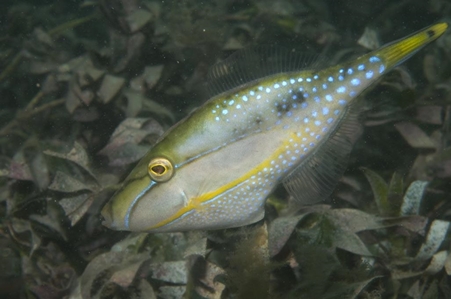General Description
Body long, slender, highly compressed, covered in close-set spines; two widely separate dorsal fins, the first a stout four-edged spine with serrate edges, the second minute. Males pale greenish, lighter below with black-edged blue bridle-like stripes in front of the eyes, blue spots on the belly and above the anal fin, and a distinctive black band near the edge of the tail. Females and juveniles are mottled brown often with black spots, sometimes with an indistinct bridled pattern before the eyes. Adult males are distinctive and readily identified by the black-edged blue stripes on the head and mid-side. A small species reaching 14 cm, commonly to 8 cm.
Biology
Juveniles and females are very similar to those of the Toothbrush Leatherjacket (Acantholuteres vittiger) and difficult to identify.
Habitat
Shallow bays and estuaries amongst seagrass beds and macroalgae, in depths of 1-15 m.
Reefs
Seagrass meadows
Distribution guide
Southern Australia.
Species Group
Depth
Water Column
Max Size
14 cm
Diet
Carnivore
Commercial Species
No
Global Dispersal
Native to Australia
Identify
Conservation Status
- DSE Advisory List : Not listed
- EPBC Act 1999 : Not listed
- IUCN Red List : Not listed





